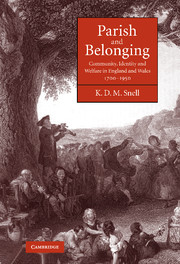Book contents
- Frontmatter
- Contents
- List of figures
- List of tables
- Preface and acknowledgements
- 1 Introduction – belonging and local attachment
- 2 The culture of local xenophobia
- 3 Settlement, parochial belonging and entitlement
- 4 Rural societies and their marriage patterns
- 5 ‘A cruel kindness’: parish out-door relief and the new poor law
- 6 Nailed to the church door? Parish overseers and the new poor law
- 7 Three centuries of new parishes
- 8 ‘Of this parish’: gravestones, belonging and local attachment
- 9 Conclusion – belonging, parish and community
- Select bibliography
- Subject and persons index
- Places index
8 - ‘Of this parish’: gravestones, belonging and local attachment
Published online by Cambridge University Press: 27 July 2009
- Frontmatter
- Contents
- List of figures
- List of tables
- Preface and acknowledgements
- 1 Introduction – belonging and local attachment
- 2 The culture of local xenophobia
- 3 Settlement, parochial belonging and entitlement
- 4 Rural societies and their marriage patterns
- 5 ‘A cruel kindness’: parish out-door relief and the new poor law
- 6 Nailed to the church door? Parish overseers and the new poor law
- 7 Three centuries of new parishes
- 8 ‘Of this parish’: gravestones, belonging and local attachment
- 9 Conclusion – belonging, parish and community
- Select bibliography
- Subject and persons index
- Places index
Summary
I am a stranger and a sojourner with you: give me a possession of a burying place with you, that I may bury my dead out of my sight.
Each in his narrow cell for ever laid, The rude Forefathers of the hamlet sleep.
Anyone who looks at gravestones in church or chapel burial grounds will observe a very frequent feature. It was once extremely common to add to the name of the deceased further details about where they were ‘of’ or ‘from’. Very frequently the phrase used was ‘of this parish’. One typical inscription reads: ‘Here lieth the Body of joan the wife of walter Williams of Baddon in the Parish of Brideftow’, to take an example dated 1774 from Lydford in west Dartmoor. Other inscriptions may take the form of ‘In Memory of [name], of this parish’, or ‘of the parish of …’. The wording can vary in a number of ways. Sometimes one finds the person, or his or her spouse or parents, being ascribed to a certain place rather than ‘this parish’, a place that may be a small settlement or even a house address, through to a large city. Assuming that the memorials have not suffered much erosion (which is often the case where limestone or sandstone monuments predominate), one will find such mention of place following many deceased people's names in most areas in the eighteenth and nineteenth centuries.
- Type
- Chapter
- Information
- Parish and BelongingCommunity, Identity and Welfare in England and Wales, 1700–1950, pp. 454 - 495Publisher: Cambridge University PressPrint publication year: 2006



